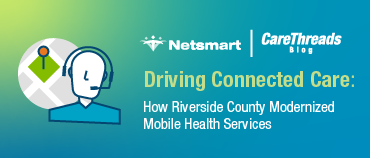Even if you think your organization has cracked the code on true integrated care, there is still likely opportunity for enhancement and growth within your current strategy. In a recent Netsmart-hosted webinar, Aware Recovery Care Chief Growth Officer, Andrea Auxier, PhD, and Big Health Director of Research, Jeanette Waxmonsky, PhD, took a deep dive into the elements of integrated care, including the 6-level framework and the Integrated Practice Assessment Tool (IPAT) designed to help you close potential gaps in care in a way that’s proven to work.
Integrated care is loosely defined as a service delivery model that actively addresses the physical, behavioral and social determinants of care. While it can be achieved in most care settings, primary care is the ideal place for integration because that’s where people with mental health conditions are most likely to have contact with a healthcare professional. For example, 50-70% of primary care provider’s caseload consists of patients whose medical ailments are psychologically related.
“Integrated care can happen many different settings,” Dr. Waxmonsky said. “It’s really making sure that [services] are put together in a way that makes sense for the population and its needs.”
The evidence is there (13:00)
It’s proven that facilitating further care in addition to primary needs is crucial to not only treating the whole person but helps save costs, improves consumer experience, boosts staff satisfaction and leads to better overall health outcomes.
An integrated strategy helps foster collaborative treatment, helping providers take a team-based approach. Thus, ensuring the individual is receiving the best care possible through a multitude of resources. Bottom line, integrated care works.
The Standard Framework for integrated care (20:30 – 31:15)
Drs. Waxmonsky and Auxier developed the Integrated Practice Assessment Tool (IPAT) with their colleagues Drs. Bern Heath and Pam Wise-Romero. The IPAT is based on the SAMHSA-HRSA Standard Framework for Integrated Healthcare developed by Drs. Health and Wise-Romero. (Reference link)
According to the Standard Framework, there are three buckets in which integration falls:
- Coordinated care – this level of care includes bi-directional exchange of information, usually written or electronic, from one provider to another. For example, a medical provider sharing information for a behavioral health in a standard referral model. Both services are operating separately with either occasional information sharing or routine information sharing.
- Co-located care – this level of care includes basic collaboration, either onsite or virtually. The care is still delivered separately with separate documentation. For example, a behavioral health provider sees the patient in the primary care setting. In this level, there are few to no standard protocols for integration.
- Integrated care – this level of care requires fundamentally changing how your practice operates. Integrated care means incorporating a team-based approach to services within your clinic, including both physical and behavioral health. This includes real-time interventions, screening protocols, shared documentation and open access to records.
The graphic below shows the three levels, as well as two sub-levels within each category.

Where does your electronic health record EHR platform play a role? According to Dr. Waxmonsky, part of it is having your clinical workflows built into your EHR, which can include screening protocols, documentation and assessments. Using your EHR to implement integrated care can also come with the ability to communicate via secured messaging within your EHR, both with the patient and among providers.
“Your EHR should give you access to the most updated records and medications list at all times,” Dr. Waxmonsky said. “This kind of real-time access within the technology allows providers to know what’s exactly happening while helping track how the individual is responding to various services.”
Integrated Practice Assessment Tool (32:40)
Derived from SAMHSA-HRSA levels of integration, the IPAT tool was initially created for a Medicaid behavioral health contract bid in Colorado.
“We needed to have a practical, easy and quick way to measure integration within these Colorado clinics,” Dr. Auxier said. “We wanted a tool that could be done within 5-10 minutes that would also address bi-directional integration without a bunch of academic jargon.”
The IPAT looks at integration across the three levels mentioned above, as well as an additional level dubbed pre-coordinated care for clinics just aren’t at the coordinated care level yet. All answers within the assessment are either a “Yes” or “No”, aimed at having the simplest response and scoring possible.
The IPAT is best completed with two or more people in the organization to get the most accurate results. With just four questions, the simple yet effective tool tells users which level of integration they’re at. Now over eight years later, the IPAT is used far and wide in the public domain by organizations across the country.
“The IPAT can best be described as ingenuity born from necessity from four health care leaders who are passionate about integrated care,” Dr. Auxier noted: “We never envisioned it would be used in so many different ways within organizations and care settings. We just wanted to take this really messy thing called integration and make it accessible for people.”
For more regarding IPAT, check out the webinar starting at 44:00 for an FAQ. Interested in taking the IPAT? Check out the assessment here.
Why measure integration? (40:25)
You may be wondering what the benefit of measuring your organization’s integration level is. According to Dr. Auxier, it depends on where you sit. She explains it like this:
If you’re working on a clinical practice, you might use it for practice transformations and establish a baseline to monitor performance over time. If you’re working at the state level, you might want to assess the readiness of your provider network to deliver this kind of care. Or you can compare your operations to other regions within the state.
If you’re a payer, you might be interested in the association between the level of integration and selected clinical utilization or cost outcomes. You could also use this to establish thresholds for different payment structures.
The IPAT offers valuable insight for all provider organizations across all service lines. Plus, it’s easy, quick and above all, available at no cost.
Tips, tricks and lessons learned (51:50)
Achieving the highest level of integration that also makes sense for your organization is not always an easy feat. There are several key takeaways Drs. Auxier and Waxmonsky have learned along the way. The first being that integrated care takes time and patience.
“Integrated care is a leap of faith,” Dr. Auxier said. “Give yourself the room to explore and experiment while learning through trial and error. It’s not going to be perfect right away, and that’s okay.
When considering integration within your organization, it’s also important to remember that while behavioral health, home care or other services are appropriate for some people, integrated care is for all people. It’s all about understanding that a person can be struggling with any element of their health at any point in time, so treating a person as a person requires looking at their full picture of physical, behavioral, and social determinants of health.
Finally, integration is not one-size-fits-all. And there’s really no one “right” way to do it. The right way is the way that works for you and your patients.
“Integration doesn’t necessarily mean quality care,” Dr. Waxmonsky said. “It’s about what works for your organization, and for some that might be a level 3or 4 on the IPAT. The key is finding the level that works best for you.”
Check out the full webinar here. In addition, here are some helpful resources to help you transition from the wishing and planning stage to the actual execution of integrating care.
Agency for Healthcare Research and Quality
Integrated Care and the Collaborative Care Model – American Psychiatric Association
Advancing Integrated Mental Health Solutions (AIMS Center)
Project ECHO at the University of New Mexico









